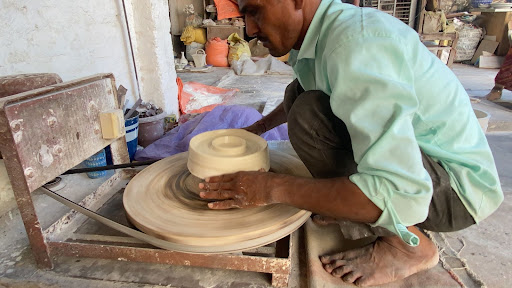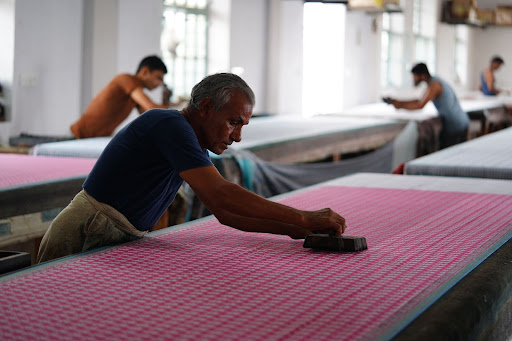Why Support Local Handloom Artisans?

India has one of the oldest textile histories. India's handwoven textiles have long been admired and purchased by textile connoisseurs worldwide because each state has a rich history of weaving and textile production.
In actuality, the textile industry in India is the second-largest sector and a major employer after agriculture. It comes as a result of the exceptionally talented master weavers and craftspeople found throughout the nation.
It is our responsibility to move forward and offer whatever assistance we can to craftsmen as members of such a beautiful nation. Here's how you can accomplish the same thing.
The History of Indian Handloom
The story of our Indian handloom is very long and exciting. The History of Indian Handloom dates back to the time of Mohenjo Daro. The story began when archeologists mined some woven and dyed cotton fabrics from the ruins of Mohenjo Daro, and the Vedas gave us different weaving styles.
Indian handloom industry finds its roots deeply concealed in tradition and the love for nature. Right from scratch, i.e., yarning, dyeing the yarn and weaving it on the loom, everything is done by the skilled handloom artists themselves.
The tools used in manufacturing these beautiful pieces of tradition are made from wood and bamboo (sometimes). These techniques do not consume any unit of electricity for product completion. The skilled artisans accomplish the complete fabric production process in the most eco-friendly way possible.
Reasons Responsible for the Decline of Indian Handloom
The Indian handloom sector being a clothing industry too, has started to face intense competition from its own fake versions and designs, which are created by the new power looms, which are the gift from the technological revolution of the 1990s. Power looms that work entirely using electricity, steam and water have replaced the traditional fabric weaving method.
The introduction of power looms has become the biggest threat to the handloom artisans. No doubt machines work faster than we humans, but the finishing that is only achieved by those experienced hands cannot be achieved by machines. The invention of these weaving machines has made artisans lose their jobs.
These reasons affected not only the artisans but also the government’s funding and protection policies. Because of this, the cost of pure fiber (yarn) has touched the sky, making it too expensive to afford. Despite the price rise in the raw materials, those talented artists' wages remain unchanged. All these factors made many weavers quit their job and choose work in which they have zero experience, causing the majority of the weavers to go extremely poor.
The Effects of COVID-19 on the Handloom Field
Handloom textiles and handicrafts are the heart of our Indian heritage, and fabric weaving is the largest source of income for a vast number of rural residents. The invention of power looms hollowed the strong pillars of the Indian handloom industry, and the outbreak of the COVID-19 pandemic made the situation worse than ever. Because of the lockdown, the factories were allowed to work with only 50% of their staff, which made factory owners fire half of their staff, making many poor artisans lose their jobs and face more financial crises.
The lockdown brought a stop to the whole handloom sector. There was no sale, which brought no income to the manufacturer. As he did not receive any income, from where would he pay his laborers? Everything stopped all of a sudden.
How can we support our talented artisans?
- Buy from Handloom Artists
Don’t let the shiny bright lights of fancy shopping malls lure you. Give the talented artisans a try. Your one step towards buying from them will motivate them and help them earn some bucks to run their house. Instead of buying clothes and other accessories from malls that charge so much more, buy handwoven clothes from a handloom store that works directly with skilled artisans and brings their created masterpieces to you.
- Buy From Local Fairs
Local fairs have become an excellent option for bringing artists from all around the country and their created handicrafts under one roof. However, the pandemic outbreak put a halt to these fairs and disrupted the flow of work of the artisans. Shop from the local fairs and reach your hand out to save our drowning handloom industry.
- Support Handloom Campaigns
These skilled artisans are the ones that are working day and night to help our Indian heritage stay alive. They are the ones who have preserved our heritage for so many generations. Individually, our assistance might seem like a drop in the ocean, but it takes many drops to form a wave. Artisans from various areas have launched campaigns to aid in their sustainability.
- Make Everyone Aware
Numerous government programs have been launched encouraging people to support the handloom sector and artists. Numerous local weavers and artists profit from these initiatives and the public's support, which helps them thrive. We can all speak up for these regional artisans on social media and in our personal networks. Give them a shoutout on your Instagram to support any struggling local craftsmen or small businesses you know. It's true what they say: A thousand miles are traveled in a single step.
Ending Note
Indian handicraft is the one that makes us cherish our Indian heritage, and the handloom artisans are the ones that bring out ancient art and culture to life. They are the ones who have been carving a legacy of our art, land, culture and traditions into tangible assets.
If you honestly want to help the handloom industry flourish as it did before, take a step forward and buy goods from handloom stores that work with artists without any middlemen. This will be the most significant contribution to the artists.
















